
|   |

|   |
Noh - Koodiyattam interface and the arousal of creativity January 17, 2012 “The actor’s movement evolved in Noh theatre from the soulful rendering of the word. It is after listening to the words uttered by the actor that the audience comes to notice its conceptualisation. The fact of the actor uttering the word marks Noh as a unique theatre model,” observes Noh master Shimizu Kanji. He was talking at the Comparative workshop on Noh and Koodiyattam organized at Natanakairali, Irinjalakuda. He also said that, “Tonal variations become possible in the breath of sound related to the five internal organs. With this, sound also expresses as a coming together of Yin (feminine) and Yang (masculine). Elaborate costumes impose limitations on body movements. The mask worn also limits sight. The actor has to present characters from within such constraints.” “The actor has to channel the internal energy rather than external gestures to evolve the character on stage. The stage presence of the actor is conceived as ‘hana’ (flower). The aura of the actor is likened to the aroma of the flower. All the acting concepts in Noh are very much shaped around the tenderness of the flower. It is an acting style that is totally undemonstrative and so, in conceiving characters it rejects the influence of realism,” he further said. 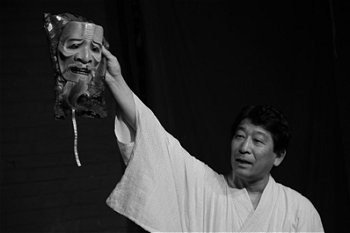 Shimizu Kanji showing a Gaku mask 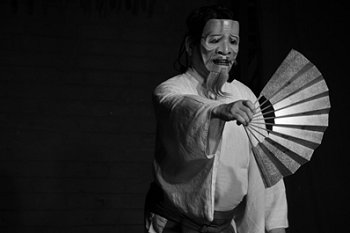 Shimizu Kanji performing with a Gaku mask Koodiyattam maestro G Venu elaborated on the states of the individual, actor and character in Koodiyattam. He explained, “According to the abilities developed in the training period, the actor stands on bent knees, holds breath in the waist. It is in this superhuman position that the body emanates energy. It is in Natyadharmi that there is stylization of the four acting modes, namely Aangikam, Vaachikam, Aaharyam and Satvikam. The dominant bhava or emotional state created in the mind of the audience through this transforms to Rasa or aesthetic enjoyment. In Koodiyattam, the dominant bhava helps the actor to identify with the character.” “Noh tradition has always acknowledged India; our art evolved from Buddha. This is revealed in the 14th century treatise on the aesthetics of Noh theatre composed by our teacher Zeami,” said Shimuzu Kanji. 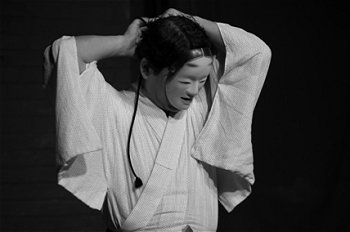 Shimizu Kanji tying a Kagura mask 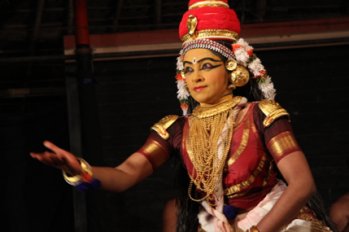 Kapila Venu performing ‘Parvativiraham’ Shimuzu demonstrated 3 different types of characters, a Kami mai (young God without mask), a Geku (an aged God with a mask), and a Kagaru (Goddess with a mask). He has also performed a portion from the play ‘Fujito’ in which a warrior was awarded a huge property for his outstanding service in a war. In fact, he had murdered a fisherman who helped him to win the battle. The murdered fisherman appeared as a ghost full of rancour, anger and suffering, accuses the warrior, recounts his experience of being murdered and thrown into the water. Shimizu showed his command and dexterity in the emotional rendering and enacting of this piece. This joint venture between Tokyo National University of the Arts and Natanakairali was spread over a week from Dec 28, 2011 to Jan 4, 2012. Apart from Shimuzu Kanji, others who came from Japan to participate in the workshop included Hiroshi Maruyama, Abdur Rahman, Chie Kamino, Emi Okada, Nao Nishhare and Yuri Kitaya who are researchers in this field. G Venu and Kapila were the main participants in the discussions on Koodiyattam. At this informal cultural interface, Swami Hari Om Ananda gave lec-dems on Yoga and Nirmala Panicker on Mohiniattam. Ammannur Rajaneesh Chakyar and Pothiyil Ranjith Chakyar presented acting concepts in Koodiyattam. Kapila presented ‘Parvathiviraham’ as Nangiarkoothu. The Koodiyattam troupe of Natanakairali presented the scenes from the first act of ‘Sakuntalam.’ The background percussion ensemble was taken care of by Kalamandalam Rajeev, Kalamandalam Narayanan Nambiar, Kalamandalam Hariharan and Kalanilayam Unnikrishnan. Kalanilayam Haridas elaborated on the make up in Koodiyattam. 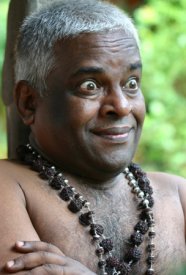 G Venu demonstrating Navarasa
Venu said that this is the fourth interface between Koodiyattam and Noh which were proclaimed as “intangible cultural heritage” by the UNESCO. Koodiyattam and Noh were presented together for the first time in the symposium ‘Into the Scared Waters’ in Dalhousie organized by the Asia Pacific Performing Arts Network. Guru Ammannur Madhava Chakyar and Kapila presented Koodiyattam while Kanze Fusao Okomoto presented Noh drama. In 2002 under Manoj Jo Matsura and in 2005 under Umevaka Norinega, there were face to face programmes organized at Natanakairali between Noh and Koodiyattam experts. Both Shimuzu Kanji and G Venu opined that such an interface between Noh and Koodiyattam will arouse the creative potential of the practitioners. |